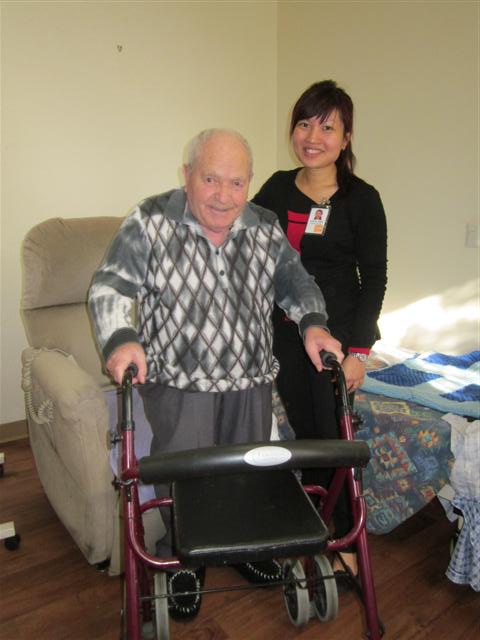Pain Management at TLC'S Noble Gardens - Vito's Story
Pain Management at TLC'S Noble Gardens- Vito's Story
TLC Noble Gardens is 130 bed aged care facility operated by the privately owned aged care provider, TLC Aged Care. The facility has 102 general beds and a 28 bed specific dementia care unit. As a new service, TLC Noble Gardens set up a specific pain management programme (PMP) in June 2011 starting with five residents. One of them was Vito Cannizarro and this article starts with Vito's story.Vito Cannizarro was admitted to TLC Noble Gardens with chronic back, hip and knee pain. The pain was severe and debilitating. His medical history showed that he had a fractured vertebrae (L3) and spinal compression. He also had Parkinson's disease and had to be transferred via a standing machine. At the time of admission to Noble Gardens his level of mobility was "physical assistance with transfer and ambulation". He was non ambulant with a very high Activities of Daily Living Needs assessment. (ADL). Vito was also an extremely high falls risk whenever he tried to get out of his wheelchair, chair or bed. It was for these reasons that he was placed at Noble Gardens.
To help cope with the pain, Vito was taking panadol three times daily and regular endone, a scheduled and powerful medication to help him with his high pain levels. His level of discomfort resulted in behavioural problems such as refusal of care and obvious anxiety and agitation. Physical assistance was being refused because any attempt to help often resulted in more pain. His reaction to the care staff members was understandable.
Vito was one of the first persons to be assessed and treated by the Pain Management Program (PMP) which is run by a contracted physiotherapist. The therapist is based at the facility five days a week for 5-8 hours a day depending on workload. The pain clinic combines three main therapy options:
- TENS (transcutaneous electrical nerve stimulation) machine treatment. As the name suggests, a TENS machine uses an electrical current to stimulate the nerves for therapeutic purposes.
- Gentle and basic exercise to ensure muscles around the affected area remain flexible and as strong as possible.
- Continual massage therapy.
Vito was reviewed in September, three months after being enrolled in the PMP. The following outcomes were achieved:
- Based on the facility's formal pain assessment charts, the pain in his limbs was reduced from severe to moderate pain.
- Despite frequent falls prior to and just after admission he has not had a fall since commencing treatment in the pain clinic.
- Endone was reduced to PRN and there was no use of Endone towards the end of the review period.
- Still classified as requiring "physical assistance" but he is now ambulating and has increased his participation in activities.
- He is much happier and bouts of frustration and anxiety have decreased.
Vito was again reviewed in May 2012, ten months after being enrolled in the PMP. The following outcomes were achieved:
- Vito has progressed to 'nil behaviour issues'. He is now a smiling and more cooperative resident.
- He is now ambulant and no longer requires 'physical assistance'. He still requires supervision.
At the time of writing this article it was wonderful to note that the PMP had worked so well that Vito had returned home for a week with his family, such has been the extent of his improvement. Needless to say Vito's wife and family are thrilled to "have the old Vito" back. Upon his return however Vito has claimed that he is glad to back at the facility so that he can recommence his routine pain clinic therapy. It has been noted that since Vito returned home and was not being treated his pain symptom started to return.
There were five residents in the trial of the PMP. The results for the other four residents were as follows:

 Thirty eight residents (30% of the total resident population) are now enrolled in the PMP and it is now a fully integrated part of the facility's care program. Facility Quality Officer, Dee Lambert explains, that five years ago some residents may not have their pain fully diagnosed, let alone treated in such a multi-faceted way. A major review is again scheduled to take place and everyone looks forward to reviewing the findings.
Thirty eight residents (30% of the total resident population) are now enrolled in the PMP and it is now a fully integrated part of the facility's care program. Facility Quality Officer, Dee Lambert explains, that five years ago some residents may not have their pain fully diagnosed, let alone treated in such a multi-faceted way. A major review is again scheduled to take place and everyone looks forward to reviewing the findings.
Readers of this article should also note that the PMP does not have a physical presence in the facility. All treatments are done in the residents own room. TLC Noble Gardens is fortunate to have large single rooms for all residents. The staff suggests that doing the pain management program in the residents' own room makes the service more of a "home" experience that is akin to a community service type visit. This adds to both the "privacy and one on one feeling of the service". Another critical element of the program is the trust that has to be built between the resident and the therapist. To make this program work the therapist has to build a relationship that is warm and supportive. It is also a wonderful boost for the staff to see the look of expectation on the resident's face when the pain clinic staff come calling.
0 comments